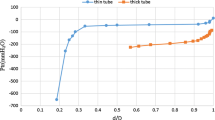Abstract
The theory of the flow of an incompressible, inviscid fluid through an elastic tube is developed and applied to a simple model of the female urethra during micturition. The importance of the fact that the flow velocity is comparable with the velocity of longitudinal elastic waves on the urethra is stressed. Flow rates and urethral profiles at different bladder pressures are calculated and found to agree qualitatively with experimental observations. In particular, it is shown that an elastic constriction near the mid-point of the urethra leads directly to an asymmetrical profile, funnelling down from the bladder neck to the constriction, and remaining narrow between the constriction and the external meatus, even in a urethra elastically symmetrical about the constriction. It is shown that the flow rate is governed by the elastic properties of the constriction, and that the effect of viscosity on the flow is relatively small, justifying the idealization that the fluid is inviscid.
Sommaire
Cet article présente la théorie du débit d'un liquide incompressible et non visqueux dans un tube élastique et l'applique à un modèle simplifié de l'urètre de la femelle pendant la miction. On insiste sur l'importance du fait que la vitesse du liquide est comparable à la vitesse de propagation des ondes élastiques longitudinales sur l'urètre. Le débit et les profils urètraux sont calculés pour différentes pressions de la vessie, et concordent qualitativement avec les observations expérimentales. En particulier, on montre qu'un étranglement élastique proche du point-milieu de l'urètre entraîne un profil asymétrique, descendant en entonnoir du col de la vessie jusqu'au point d'étranglement, et restant étroit entre l'étranglement et le méat externe, même dans une urètre symétriquement élastique autour du point d'étranglement. Le débit dépend des propriétés élastiques du goulot d'étranglement et l'effet de la viscosité sir le débit est relativement faible, ce qui justifie l'hypothèse simplificatrice du liquide non visqueux.
Zusammenfassung
Die Theorie des Flusses einer nichtkompressiblen, nicht viskösen Flüssigkeit durch eine elastische Röhre wird entwickelt und auf ein einfaches Modell der weiblichen Harnröhre während der Miktion angewandt. Die Bedeutung der Tatsache, daß die Strömungsgeschwindigkeit der Geschwindigkeit der elastischen Longitudinalwellen auf der Urethra vergleichbar ist, wird unterstrichen. Strömungsgeschwindigkeiten und Urethralprofile bei verschiedenen Blasendrucken werden berechnet. Sie stimmen qualitativ mit den experimentellen Beobachtungen überein. Insbesondere wird gezeigt, daß eine elastische Konstriktion in der Nähe der Mitte der Harnröhre einem asymmetrischen Profil führt, welches sich trichterförmig vom Blasenhals zu der Konstriktion erstreckt und zwischen der Konstriktion und dem Ausgang eng bleibt, auch bei einer elastisch symmetrischen Konstriktion. Es wird gezeigt, daß die Strömungsgeschwindigkeit von den elastischen Eigenschaften der Konstriktion abhängt, und daß der Einfluß der Viskosität auf den Durchfluß relativ gering ist; daher die Berechtigung zu der idealisierenden Annahme einer nicht viskösen Flüssigkeit.
Similar content being viewed by others
Abbreviations
- A :
-
2π × elastic constant per unit length of wall, dyn cm−2
- a :
-
cross-sectional area of fluid stream, cm2
- c :
-
velocity of waves on elastic tube, cm sec−1
- dx :
-
infinitesimal element of length along urethral axis, cm
- \(\frac{{d ,}}{{dr}} \frac{{d }}{{dx}}\) :
-
derivatives with respect tor, x, cm−1
- \(\frac{{\partial ,}}{{\partial t}} \frac{{\partial }}{{\partial x}}\) :
-
partial derivatives with respect to timet, distancex, sec−1, cm−1
- H :
-
enthalpy per unit mass of fluid, erg g−1
- l :
-
length of urethra, cm
- P :
-
pressure of fluid within urethra or tube, dyn cm−2
- P f :
-
frictional energy loss per unit volume of fluid passing through urethra, dyn cm−2 or erg cm−3
- P o :
-
bladder or reservoir pressure, dyn cm−2
- Q :
-
volume flow rate, cm3 sec−1
- Q max :
-
maximum volume flow rate through elastic tube, cm3 sec−1
- R :
-
urethral radiusr × scaling factor(A−P o )/A, cm
- R v :
-
Reynolds number of flow
- r :
-
radius of urethra or elastic tube, cm
- r c :
-
radius of urethra or tube where flow velocity is sonic, cm
- S :
-
entropy per unit mass of fluid, ergoK−1g−1
- s :
-
unstretched radius of urethra or elastic tube, cm
- s c :
-
value ofs for which flow velocity is sonic, cm
- s m :
-
minimum value ofs in urethra or elastic tube, cm
- T :
-
absolute temperature of fluid,oK
- v :
-
velocity of flow, cm sec−1
- v s :
-
velocity of stream outside urethra, cm sec−1
- x :
-
distance measured along urethral axis, cm
- α:
-
\(3^{\tfrac{3}{4}} /4\underset{\raise0.3em\hbox{$\smash{\scriptscriptstyle\cdot}$}}{ \doteq } 0 \cdot 57\)
- γ:
-
defined bys=s m (1 + γ2(δx)2) in region of quadratic variation ofs, cm−1
- δx :
-
(small) distance measured along axis from urethral constriction, cm
- η:
-
viscosity of fluid, poise, P
- ρ:
-
density of fluid, g cm−3
References
Backman, K.-A. (1965) Micturition in normal women.Acta chir. scand. 130, 357–70.
Landau, L. D. andLifshitz, E. M. (1959)Fluid Mechanics, p. 350, Pergamon Press, London.
Smith, J. C., Edwards, D. andBryant, G. H. (1966) A practical method of measuring urethral resistance to micturition.Br. J. Urol. 38, 542–6.
Zinner, N. R. andRitter, R. C. (1967) In:The Neurogenic Bladder, p. 18, Edited by Boyarsky, Williams & Wilkins, Baltimore.
Author information
Authors and Affiliations
Rights and permissions
About this article
Cite this article
Griffiths, D.J. Urethral elasticity and micturition hydrodynamics in females. Med. & biol. Engng. 7, 201–215 (1969). https://doi.org/10.1007/BF02474176
Received:
Issue Date:
DOI: https://doi.org/10.1007/BF02474176




